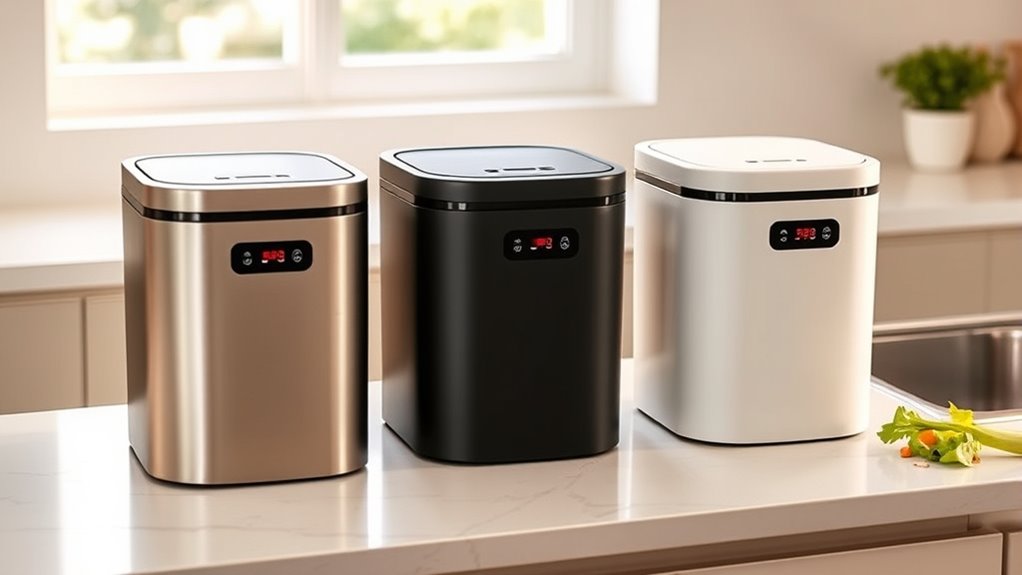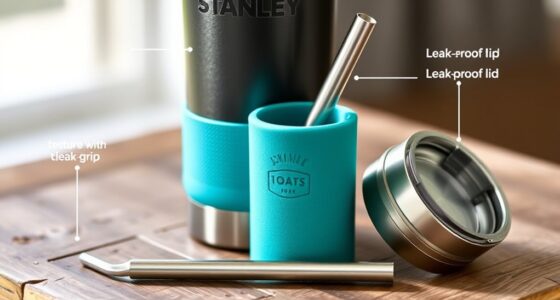If you’re looking for the best electric compost bins for your kitchen, I recommend the TOPZEE Electric Compost Bin for its odor control and compact size, perfect for daily use. The AMZCHEF Electric Composter offers quick waste processing with a 4L capacity, ideal for small households. The Airthereal Revive features advanced odor filtration and efficient composting, making kitchen cleanup easy. Keep exploring to find out more about each model’s features and how they can fit your household needs.
Key Takeaways
- Choose models with suitable capacity for your household size to ensure efficient waste processing and minimal emptying frequency.
- Prioritize bins with effective odor control features like activated charcoal filters and sealed lids for a fresh kitchen environment.
- Opt for quiet operation under 40 decibels and easy-to-clean surfaces to simplify maintenance and reduce noise disturbance.
- Select energy-efficient units that use less than 1 kWh per cycle, with automatic or touchless controls for effortless use.
- Consider compact, space-saving designs with fast composting modes to enhance convenience and support sustainable waste reduction.
TOPZEE Electric Compost Bin for Kitchen

If you’re looking for an efficient, space-saving way to compost kitchen waste indoors, the TOPZEE Electric Compost Bin is an excellent choice. It offers smart systems with fast (4 hours) and standard (6 hours) modes, ensuring quick and thorough food waste processing. Its stainless steel blades accurately control temperature and humidity for even crushing, reducing waste volume by up to 90%. The compact design, measuring just 9.05 x 9.05 x 10.62 inches with a 3-liter capacity, fits perfectly in any kitchen corner. Quiet and energy-efficient, it operates below 40 decibels and uses only 0.51 kWh per cycle, making it unobtrusive and economical.
Best For: households seeking an efficient, space-saving, and eco-friendly indoor composting solution for kitchen waste.
Pros:
- Compact and space-efficient design fits easily in any kitchen corner
- Fast processing modes (4 and 6 hours) for quick waste conversion
- Low noise operation (<40 decibels) and energy-efficient at 0.51 kWh per cycle
Cons:
- Requires regular replacement of activated charcoal filters every 3-6 months
- Limited capacity of 3 liters may need frequent emptying for larger households
- Some users may find the initial setup and maintenance of filters and cleaning routine slightly cumbersome
AMZCHEF Electric Composter for Kitchen, 4L Countertop Compost Bin

The AMZCHEF Electric Composter’s compact 4L capacity makes it an ideal choice for busy individuals or small households who want to effortlessly turn kitchen waste into nutrient-rich fertilizer. It quickly composts food scraps in just 4 to 7 hours using thermal technology, with two modes tailored to different amounts of waste. Its sleek design fits modern kitchens without taking up much space. The unit operates quietly, employs activated carbon filters and a turbine vent to eliminate odors, and features easy cleanup with a rust-proof, non-stick bucket. Safe and user-friendly, it’s perfect for reducing household waste and creating eco-friendly compost for your plants.
Best For: busy individuals or small households seeking an efficient, odorless, and eco-friendly way to compost kitchen waste effortlessly at home.
Pros:
- Rapid composting process (4-7 hours) using advanced thermal technology
- Compact, sleek design fits seamlessly into modern kitchens and small spaces
- Quiet operation with odor reduction features like activated carbon filters and turbine vent
Cons:
- Limited 4L capacity may require frequent emptying for larger households
- Higher initial cost compared to traditional compost bins
- Requires regular maintenance of filters and cleaning to ensure optimal performance
Airthereal Revive Electric Kitchen Composter

For those seeking an efficient way to manage kitchen waste without the mess or odors, the Airthereal Revive Electric Kitchen Composter stands out. It turns food scraps into dry powder by drying and grinding, reducing trash volume and odors while creating fertilizer for plants. Equipped with sharp SHARKSDEN Trinity Blades, it crushes various food wastes quickly and thoroughly. Its 2.5-liter capacity and one-button operation make it simple to use—just add waste and press start. The cast aluminum bucket is easy to clean and dishwasher safe, simplifying maintenance. Biodegradable carbon filters control odors, allowing me to compost throughout the day and have dry, odor-free waste ready in about four hours.
Best For: households and individuals seeking an eco-friendly, odor-free, and efficient solution for managing kitchen waste and reducing trash volume.
Pros:
- Efficiently converts food scraps into dry powder using sharp Trinity Blades for thorough grinding
- Easy to operate with a simple one-button system and dishwasher-safe cast aluminum bucket for hassle-free maintenance
- Odor control features, including biodegradable carbon filters, ensure a fresh-smelling kitchen environment
Cons:
- Limited 2.5-liter capacity may require multiple runs for larger households
- The drying and grinding cycle takes approximately 4 hours, which may not suit urgent waste disposal needs
- Requires electricity, which could increase energy consumption compared to traditional composting methods
Factors to Consider When Choosing an Electric Compost Bin for Kitchen

When choosing an electric compost bin, I focus on capacity to match my household needs and how quiet it operates so it doesn’t disturb daily life. I also consider how well it controls odors and how easy it is to clean, since convenience matters. Ultimately, I look at energy efficiency to keep running costs low while staying environmentally friendly.
Capacity Needs
Choosing the right capacity for your electric compost bin depends on how much food waste your household generates daily. If you’re a single person or a couple, a small bin of 3-4 liters may suffice, reducing the need for frequent emptying. For larger households, consider a bin with a capacity of 9 liters or more to handle higher waste volumes without constant maintenance. It’s important to match the bin’s size with your typical waste output to prevent overflow or frequent emptying. Some models feature adjustable modes or multi-stage processing, which can affect your capacity needs. Keep in mind that a larger bin might take up more space but can save you time by reducing maintenance frequency. Choose a capacity that fits your household’s organic waste production for ideal efficiency.
Noise Levels
Since electric compost bins operate quietly, they’re ideal for use in noise-sensitive areas like bedrooms and offices. Most models run below 40 decibels, thanks to advanced motor technology and sound-dampening materials, ensuring minimal disturbance. Some designs even feature insulation or noise reduction features that further lower operational sounds, making them even more user-friendly. Keep in mind, the noise level can vary depending on the mode you choose; faster or more intensive settings might produce slightly louder sounds. Regular maintenance and selecting a model with a reputation for quiet operation help maintain a peaceful environment while composting. If noise is a concern, look for bins specifically designed with sound reduction in mind, so you can compost without disrupting your daily activities.
Odor Control
Ever wondered how electric compost bins keep unpleasant odors at bay while working quietly in your kitchen? The key lies in effective odor control features. Most models use activated charcoal filters that absorb smells during composting, and regular filter replacements—every 3-6 months—are essential for continued freshness. Proper sealing lids and airtight containers also prevent odors from escaping, keeping your kitchen smelling clean. Many bins incorporate odor-neutralizing technologies like deodorizing vents or biofilters, further enhancing their effectiveness. Additionally, a sealed design minimizes odor leakage and noise, making indoor composting more acceptable in living spaces. When choosing, look for these features to ensure your compost bin maintains a fresh, odor-free environment, even during active composting.
Ease of Cleaning
Maintaining a clean compost bin is key to keeping your kitchen smelling fresh and ensuring hassle-free use. I recommend choosing a bin with non-stick coatings or easy-to-clean surfaces, which make wiping down effortless. Look for models that feature one-button automatic cleaning or self-flushing systems—these reduce manual effort and keep maintenance simple. Removable, dishwasher-safe components like the bucket or filters are a big plus, making it easy to keep everything hygienic without hassle. Activated charcoal filters that are simple to replace help maintain odor control with minimal fuss. Finally, opt for a compact design that fits comfortably in your kitchen, allowing quick access for regular cleaning. These features ensure your compost bin stays clean, odor-free, and easy to maintain daily.
Energy Efficiency
Choosing an energy-efficient electric compost bin means paying close attention to its power consumption and smart features. Look for models that use less than 1 kWh per cycle; those operating around 0.5 kWh or less are ideal for saving energy and reducing costs. Features like automatic shut-off and optimized heating elements help prevent unnecessary energy use during composting. Some bins include smart sensors that automatically regulate temperature and humidity, ensuring efficient processing without excess energy. Additionally, choosing a model with energy-saving modes or adjustable settings allows you to tailor usage to your needs, further enhancing efficiency. By prioritizing these features, you can enjoy a greener, more cost-effective composting experience that minimizes your environmental footprint.
Size & Fit
When selecting an electric compost bin for your kitchen, it’s vital to take into account its size and how well it fits into your available space. Measure the area where you plan to place it, whether under the sink or on the countertop, to guarantee a comfortable fit. Consider the bin’s capacity—options typically range from 3 to 4 liters—so it matches your household’s daily waste output without needing frequent emptying. If space is limited, opt for a compact model, but verify it still offers enough capacity for your needs. Make sure the overall size aligns with your kitchen layout to prevent clutter and allow easy access. Choosing the right size ensures convenience and helps keep your kitchen organized.
Waste Reduction
A key factor in selecting an electric compost bin is its ability to maximize waste reduction. A good unit can reduce food waste volume by up to 90%, drastically decreasing household trash. Fast composting modes, often within 4-6 hours, speed up waste conversion, making it more efficient. Using an electric compost bin also lowers reliance on landfills, helping reduce methane emissions and environmental impact. Features like high-capacity tanks and effective grinding or drying mechanisms ensure daily organic waste gets processed consistently. Additionally, odor control systems, such as activated charcoal filters, keep your kitchen smelling fresh during waste breakdown. Overall, prioritizing waste reduction means choosing a bin that’s powerful, fast, and equipped with odor management—making your composting both effective and eco-friendly.
Frequently Asked Questions
How Long Does Composting Typically Take With Electric Bins?
Composting with electric bins usually takes about 24 to 48 hours, depending on the model and the amount of waste. I’ve found that these bins speed up the process markedly compared to traditional composting, thanks to their aeration and heating features. If you add kitchen scraps regularly, you can have compost ready in just a day or two, making it super convenient for eco-friendly living.
Are Electric Compost Bins Suitable for All Types of Food Waste?
Did you know that electric compost bins can process up to 90% of common kitchen waste? I find they’re generally suitable for most food scraps, like fruit peels, coffee grounds, and vegetable scraps. However, I avoid adding dairy, meat, or oily foods, since those can cause odors or clog the system. Overall, they’re versatile but best used with plant-based waste for ideal results.
What Is the Maintenance Required for Electric Compost Bins?
Maintenance for electric compost bins is straightforward. I regularly empty the collection container to prevent odors and check the filter, replacing it as needed to keep the bin running smoothly. I also wipe down the interior and exterior to remove any residue and make sure the sensors stay clean. Doing these simple steps weekly helps my bin operate efficiently and keeps my kitchen odor-free and eco-friendly.
Can Electric Compost Bins Be Used in Small Apartments?
Did you know that over 60% of urban dwellers live in small apartments? Yes, electric compost bins are perfect for that! I’ve used one myself, and it fits neatly on my countertop. They’re compact, odor-controlled, and easy to manage, making composting simple even in tight spaces. So, if you’re in a small apartment, these bins are a smart, eco-friendly way to reduce waste without sacrificing space.
Do Electric Compost Bins Emit Any Odors or Noise During Operation?
Electric compost bins generally don’t emit odors or noise if they’re well-designed and maintained. I’ve found that they use sealed lids and odor filters to keep smells contained, and the motors operate quietly, so I barely notice any noise. Regularly cleaning the bin also helps prevent odors. Overall, they’re a discreet, eco-friendly solution that won’t disturb your home environment.
Conclusion
Choosing the right electric compost bin is like finding the perfect compass for your eco-journey. It guides you smoothly through the clutter of waste, turning your kitchen into a haven of sustainability. With the right choice, you’re not just composting—you’re planting seeds for a greener tomorrow. Let your decision blossom into a sustainable habit that nurtures both your home and the planet, making every scrap a step toward a brighter, cleaner future.









